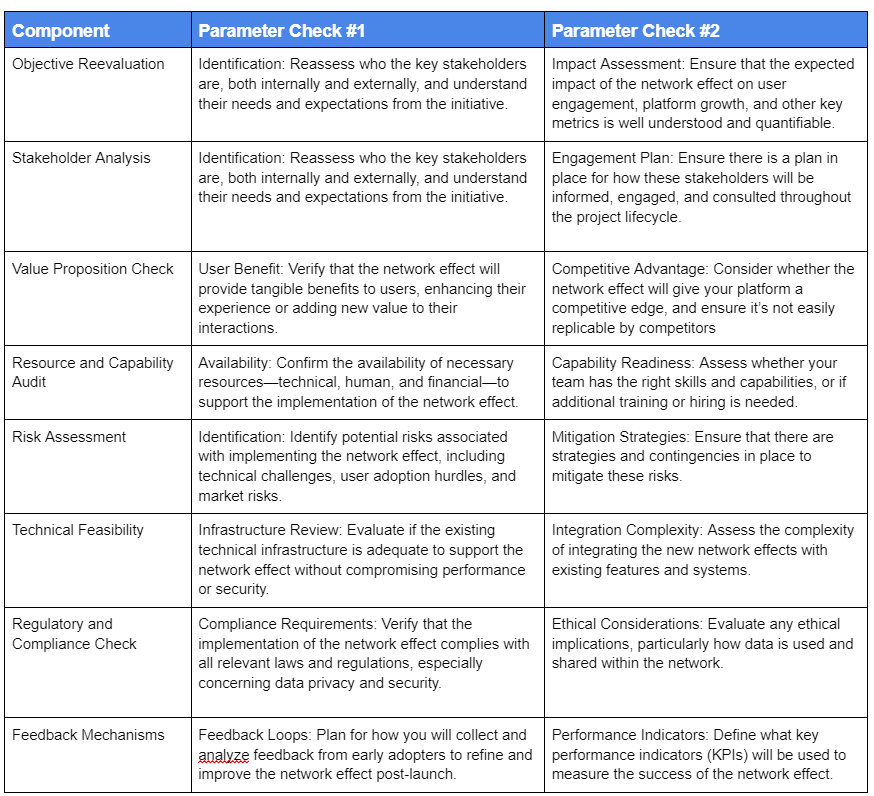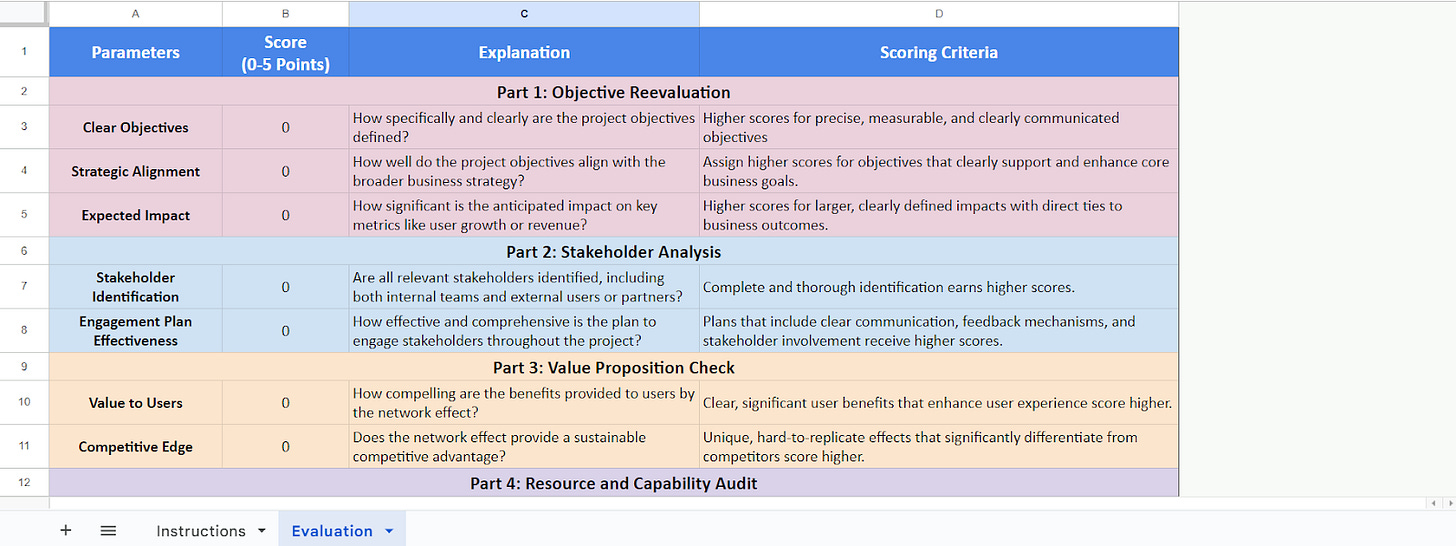Network Effects for Distribution Innovation - Planning and Validation (Part 2 of 3)
Now, we’ll dive deeper into planning and implementing network effects for B2B SaaS distribution innovation. We will validate and implement these into your offerings to hack into exponential growth.
👋 Hey, Ayush here! Welcome to this week’s ✨ free edition ✨ of Startup GTM Newsletter.
I have been building startups for the last 8 years and working with founders on GTM, growth, people-first strategies, communities and anything else about building a startup.
If you’re not a subscriber, here’s what you missed earlier:
Here is a bonus for you:
1. The 10 most common GTM myths about early-stage SaaS by ALEXANDER ESTNER
Subscribe to get access to these posts, and every post moving forward. Follow me on Linkedin and Twitter. Want to discuss about collaboration or GTM?
Before we dive deeper into planning for network effects in B2B SaaS, let’s quickly recap what we’ve explored so far:
Types of Network Effects: We discussed various network effects that can elevate a B2B business, enhancing both value and stickiness as your user base grows.
Identifying Opportunities: How can you spot potential network effects in your operation? This question is crucial for any leader looking to innovate strategically.
Measuring Effectiveness: We've looked at methodologies to assess the impact of your network effects initiatives. Are they truly delivering the expected value?
Have you started noticing any potential network effects in your business yet? Reflect on this as we proceed.
Practical Examples: We also reviewed real-world examples of network effects in action, providing a clearer picture of theory applied in practice.
Here is a recap that outlines types of network effects alongside pertinent examples, designed to summarize our discussions.
What’s next?
How will you apply these insights to create a competitive edge in your market? Let's explore actionable ideas and frameworks to not only identify but effectively implement and scale network effects within your B2B tools.
Here are the topics that I am going to cover in this newsletter:
Strategic Ideas for Network Effects:
Actionable ideas for leveraging network effects in B2B tools across verticals
Planning for Network Effects in B2B:
Detailed pointers on planning, framework development, hypothesis building, testing, and implementation processes.
Evaluation Framework
A framework to review initiatives before strategic planning discussions with your team.
Launching for Pilot - Strategies
Strategies for planning network effects initiatives for a pilot.
Phases of Network Effects Implementation: Pilot, Launch, and Ramping.
Detailed Phase Plans: Goals, milestones, and activities
Network Effect Ideas for B2B SaaS Tools across verticals
For some of the popular use cases of SaaS tools (across Sales, Marketing, HR, Productivity and Creation), let's explore possible network effects with relevant use-case examples:
Marketing Tools:
Sales Tools:
HR Tools:
Productivity Tools:
Creation Tools:
These examples illustrate how various types of network effects can be strategically harnessed across different SaaS solutions to enhance value creation and competitive advantage within industries.
Planning for Network Effects in B2B
When a company chooses to integrate a network effect into their SaaS platform, the approach must be tailored specifically to harnessing these effects effectively. Here’s a guide to planning, building, and implementing network effects, with an emphasis on specific steps relevant to different types of network effects:
Planning
Objective Specification: Define clear goals related to the network effect, such as increasing platform stickiness or enhancing user collaboration.
Identify Critical Mass: Determine the necessary user base size to achieve a meaningful network effect. This is crucial for all types of network effects.
Stakeholder Analysis: Identify key user groups and stakeholders who will drive or benefit from the network effect. Different network effects may target different stakeholders.
Framework Specific to Network Effects
Engagement Mapping: Design how interactions facilitated by the network effect will occur, which is crucial for collaboration-driven effects like those in Slack or GitHub.
Value Proposition Design: Clearly articulate how the network effect will benefit each participant, important for all network effects but especially for two-sided markets and API ecosystems.
Feedback Systems: Plan to capture and analyze user interactions to refine the network effect continuously. This is vital for feedback loop models and community-building models.
Hypotheses and Testing Specific to Network Effects
Hypothesis Formation: Create specific, measurable hypotheses about how the network effect will impact user behavior or platform metrics. For example, "Implementing user-generated content tools will increase engagement by X%."
Segmented Testing: Use segmented rollout and A/B testing to evaluate the network effect in different user groups, particularly useful in platforms with diverse user bases.
Launch Steps:
Phased Rollout: Begin with a beta group to gauge the network effect's impact before a full launch, essential for all network effects to ensure scalability and user adaptation.
Community Engagement: For community and same-side network effects, actively manage community dynamics and contributions during rollout.
Iterative Optimization: Use the initial launch as a learning phase to collect data and refine the approach based on actual user behavior and feedback.
Important Steps:
Monitoring Network Health: Continuously monitor how the network effect impacts the platform ecosystem, focusing on metrics like user engagement, network growth, and user retention.
User Education and Support: Educate users on how they benefit from and can contribute to the network effect, crucial for API ecosystems and professional identity networks like LinkedIn.
Ongoing Optimization and Scaling: Regularly update and scale the network effect functionalities as more users join the platform, particularly important for data-driven and utility-based network effects.
This refined approach ensures that network effects are not only implemented effectively but are also continuously optimized to maximize their impact on the platform and its users. Each step and consideration is tailored to support specific types of network effects, enhancing the strategic focus and effectiveness of integration efforts.
Evaluate your network effects
Before proceeding to the planning discussion with your team on a network effects initiative, it's crucial to have a solid framework to recheck the strategic alignment and readiness of the proposed initiative.
This pre-planning review ensures that all aspects of the network effect are well-thought-out, reducing risks and aligning expectations. Here’s a structured framework to guide this evaluation:
You can download the “Evaluating your Network Effect Idea” template here.
Launching for Pilot - Strategies
For a founder looking to explore and build network effects, pilot launch is extremely crucial. Each type of network effect presents unique opportunities and challenges. Below, I'll outline how to plan for the initial execution for each network effect, providing strategies tailored to each category.
1. Creator (Notion, Airtable)
Execution Planning:
Platform Enrichment: Focus on enabling creators to build and share their content or templates effectively. Ensure that the platform supports diverse creation tools that creators need to create and publish.
Incentives and Rewards: Implement reward mechanisms that encourage frequent content creation and sharing.
Community Engagement: Foster a community of creators through events, workshops, and collaborative projects to keep them engaged and active.
2. Community (Salesforce, Hubspot)
Execution Planning:
Community Building Tools: Develop tools and features that facilitate community interactions, such as forums, discussion groups, and live chat functionalities.
User Recognition Programs: Create programs that recognize and reward active community members to encourage continued engagement and contribution.
Localized Content: Ensure the platform supports localized content and community guidelines that resonate with the regional culture and norms.
3. Expertise (Salesforce, Adobe, Quickbooks, MixPanel, Wordpress)
Execution Planning:
Expert Content Creation: Encourage experts to create high-quality content by providing them with advanced tools and visibility on your platform.
Learning and Development: Offer webinars, courses, and certifications that allow users to gain recognized expertise in specific areas.
Expert Network: Build a network of recognized experts within the platform who can mentor others and provide consultancy.
4. Two-sided Platforms (Android, iOS, Salesforce Lightning, Twilio, Zoom, Tracelink)
Execution Planning:
Balanced Ecosystem Growth: Maintain a balance between the two sides of the platform (e.g., developers and users, service providers and consumers) by monitoring growth and incentivizing each side appropriately.
Integration Support: Provide robust API support, documentation, and technical assistance to encourage developers to build on your platform.
Market Matching: Implement algorithms or features that effectively match supply and demand on the platform.
5. Utility and Collaboration (Slack, Figma)
Execution Planning:
Collaborative Features: Enhance the platform with features that support real-time collaboration and communication.
Integration of Tools: Integrate with other commonly used tools and services in the region to increase the utility value of the platform.
User Training: Conduct training sessions to help users maximize the collaborative potential of the tools provided.
6. Professional Identity (Github, LinkedIn)
Execution Planning:
Professional Profiles: Encourage users to create detailed professional profiles that highlight their skills, experience, and contributions.
Networking Features: Implement features that allow for easy networking, mentorship, and professional growth within the platform.
Industry Engagement: Partner with local industry leaders and organizations to boost credibility and attract professionals.
7. Market Network with SaaS (AngelList, Honeybook)
Execution Planning:
Service Integration: Seamlessly integrate various services (e.g., project management, billing, communication) to create a comprehensive platform for freelancers and small businesses.
Community and Support: Develop a supportive community that offers users networking opportunities, advice, and resources.
Market Adaptation: Adapt the platform’s offerings to meet the specific needs and regulatory requirements of the local market.
8. Two-sided Marketplace (Medium, American Express)
Execution Planning:
Marketplace Dynamics: Carefully manage marketplace dynamics to ensure a healthy balance between supply and demand.
Quality Control: Implement quality control measures to maintain high standards within the marketplace.
Localization: Localize the marketplace to cater to regional preferences and legal requirements.
9. Data (ChatGPT, LinkedIn Sales Navigator)
Execution Planning:
Data Collection and Analysis: Implement robust mechanisms for collecting and analyzing user data to continually improve the service.
Privacy and Security: Ensure strict adherence to local data privacy and security laws.
User-driven Improvements: Use data insights to make iterative improvements to the platform, enhancing user experience based on actual usage patterns.
By tailoring the execution plans to each type of network effect, the founder can effectively leverage local strengths and opportunities, ensuring that the initiative resonates with the pilot plan and maximizes the potential of the network effects.
3 Phases of Network Effects Implementation: Pilot, Launch, and Ramping.
Defining the phases of network effect implementation can help structure the deployment and growth of your initiative efficiently.
Here’s a detailed breakdown of what to plan in each phase—Pilot, Launch, and Ramping—for each type of network effect. Each phase is outlined with goals, milestones, activities, North Star Metric, review process, timelines, and how these align with business goals.
I am covering the implementation of “Creator Network Effect” below in this part. In the next part we will cover the implementation of other 8 Network Effects. Subscribe and share with your network to receive a guide book on Network Effects.
1. Creator Network Effect (e.g., Notion, Airtable)
To achieve the milestones and goals outlined in each phase for the Creator network effect, the following systems, processes, and resources are essential:
System: Implement a robust content management system that allows for easy creation, sharing, and tracking of user-generated content.
Process: Establish a clear process for content moderation and quality control, ensuring that user-generated content meets community standards.
Resources: Allocate dedicated team members for community management, technical support for content creators, and marketing professionals to promote content creation within the community.
This detailed phase-wise planning can be adapted for each type of network effect listed. It provides a structured approach to gradually scaling the network effect, from testing and validation in the pilot phase to full implementation and growth in the ramping phase.
Each step includes clearly defined goals, metrics for tracking success, and alignment with broader business objectives, ensuring a comprehensive strategy for leveraging network effects in SaaS platforms.
If you like reading, please subscribe and share across. In the next issue, I will also share guidebooks for each network effect. If you’re interested to receive all the guidebooks of implementing “Network Effects” personally, do leave a comment here or join the chat.
💪 Bonus material (software, content, news)
—> The 10 most common GTM myths about early-stage SaaS by ALEXANDER ESTNER
Want to brainstorm your go-to-market strategy?
Subscribe, follow and connect with me on Linkedin for exclusive insights, tips, and expert advice on GTM strategies.
In case you want to connect and brainstorm your GTM with network effects, write me on ayush@startupgtm.pro














